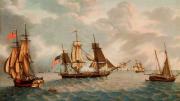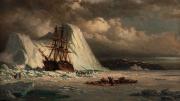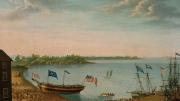“In American Waters,” a new exhibit of more than 90 paintings at the Peabody Essex Museum, portrays the magnitude of Odyssean journeys, along with the “beauty, violence, poetry, and transformative power of the sea.” Diverse works by artists Michele Felice Cornè, Georgia O’Keeffe, Thomas Hart Benton, and Amy Sherald, among others, offer a more expansive perspective on what’s been called marine painting. The genre “is so much more than ship portraits,” according to Dan Finamore, the museum’s associate director of exhibitions and Knight curator of maritime art and history. “In American Waters” takes viewers from the importance of shipping, trade, and independence in early America, through the commercial-fishing industry, and into Arctic exploration. It also highlights coastal scenes—and their connections to Native American and indigenous life—along with the timeless pleasures of swimming and bathing under the open sky. For those drawn to New England’s harbors, beaches, and Atlantic horizon, “In American Waters” (on display through October 3) also serves as a reminder of what is central to protecting coastal life amid climate change. “No matter where we live, the sea shapes all of our lives,” Finamore notes, “and continues to inspire some of the most exciting artists working today.”
Peabody Essex Museum’s “In American Waters”
Peabody Essex Museum’s “In American Waters”
From oceanic voyages to romping in the waves, a new exhibit explores relationships to water.

Click on arrow at right to view additional images
(1 of 3) Ship America on the Grand Banks, circa 1800, by Michele Felice Cornè
©2014 Peabody Essex Museum

Click on arrow at right to view additional images
(2 of 3) Icebound Ship, circa 1880, by William Bradford
©2020 Peabody Essex Museum/Photography by Kathy Tarantola

Click on arrow at right to view additional images
(3 of 3) Launching of the Ship Fame, 1802, by George Ropes Jr.
Peabody essex museum/Photography by Jeffrey R. Dykes
Published in the print edition of the July-August 2021 issue (Volume 123, Number 6), under the headline “Ocean Views.”
You might also like
Novelist Lev Grossman on Why Fantasy Isn’t About Escapism
The Magicians author discusses his influences, from Harvard to King Arthur to Tolkien.
England’s First Sports Megastar
A collection of illustrations capture a boxer’s triumphant moment.
This TikTok Artist Combines Monsters and Mental Heath
Ava Jinying Salzman’s artwork helps people process difficult feelings.
Most popular
Explore More From Current Issue

A Near-Perfect Football Season Ends in Disappointment
A loss to Villanova derails Harvard in the playoffs.







